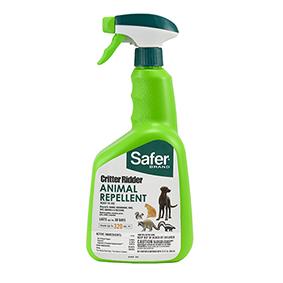





Groundhogs
How to Repel Groundhogs
Drive groundhogs out of your yard by creating an unwelcome environment with a system of powerful repellents. The step-by-step instructions below will help you stop the digging, gnawing and clawing, and keep groundhogs away for good.
1 Identify Habits

Where is your groundhog spending most of its time? What type of damage is it causing? The answers to these questions will help you choose your control method.
Common groundhog activities include:
- damaging crops like peas, beans, melons and alfalfa
- eating grasses and clover
- gnawing/clawing on wood or vegetation like trees and shrubs
- chewing through electrical wires/tubing
- digging holes and burrowing under lawn or structures
Seek out any groundhog burrows on your property - you can identify these by locating their entrances/exits. Burrows generally contain 2-5 entrance holes, each about 6-8 inches in diameter. Groundhogs often hide these holes by digging them underneath vegetation and/or loosely covering them up with leaves and sticks.
2 Choose Your Groundhog Repellent
Based upon your groundhog's habits, use the information below to determine whether a liquid, granular or electronic solution is best for you. It's important to note that the more repelling options you apply in tandem, the greater your chance at achieving long-term success.
Liquid Spray Repellents
Best For:Discouraging groundhogs from eating or chewing on plants and surfaces. Spray a liquid repellent directly onto those susceptible to damage like:

- alfalfa
- grasses
- bushes
- shrubs
- clover
- trees
- flowers/buds
- woodpiles
TIPS: Groundhogs will eat all parts of a plant - especially the woody parts. Generously spray your plant's stems and branches in addition to its leaves, flowers and buds.
Shop Liquid Repellents »Granular Repellents
Best For:Perimeter protection from groundhogs. Sprinkle a granular repellent on the ground to create a groundhog-repelling barrier around certain problem areas like:

- vegetable gardens
- burrows and dens
- flower beds
- structures
- ground cover
- pathways
TIP:Use a granular repellent to drive groundhogs from their burrows in early spring. Learn more in the Expert Tips section of this page.
Shop Granular Repellents »Electronic Repellents
Best For: Frightening groundhogs and conditioning them to stay away from large areas, without the need to reapply repellents. Electronics are versatile and discreet - use one to protect almost anything, including:

- crops
- vegetable gardens
- pathways
- gardens
- flowerbeds
- yards/lawns
- structures
- wooded areas
- ground cover
- property entryways
- ornamental/fruit trees
- shrubs
TIP: Groundhogs are skittish and easily startled, so electronics are a great alternative or add-on to traditional repellents. Motion-activated sprinklers repel groundhogs using only electricity and water, so they are great for protecting edible crops.
Shop Electronic Repellents »3 Apply as Directed

Carefully follow your repellent's instructions from start to finish. Even the best groundhog repellents won't be effective if you skip a step. Below are some important, often neglected, notes on application:
- Repellents must be reapplied periodically in order to maintain full repellency.
- Liquid repellents should only be applied in dry weather, in temperatures over 40° F. Allow a liquid repellent to completely dry before watering any treated plants.
- Granules should be sprinkled at the rate (amount of granules per square foot) indicated on the back panel to ensure the ideal level of irritation.
- Location is key when setting up electronic repellents - the sensor and sprinkler should be pointed in the direction groundhogs are approaching.

4 Reduce Attractants
A groundhog repelling plan will only be successful if you limit the available sources of food and shelter in your yard. Some steps to take include:
- harvesting crops as early as possible
- cleaning up piles of debris, brush and/or wood
- trimming back plants groundhogs may eat or use for cover
- removing tree trunks or other sources of wood on which groundhogs might grind their ever-growing teeth
TIP: Prevent groundhogs from occupying abandoned burrows by covering openings with wired fencing buried at least 1 foot below ground level.
Expert Tips
- For best results, choose Safer® Brand Critter Ridder® Animal Repellent Granulars. The best groundhog repellents repel by targeting multiple senses, like scent and taste.
- Some liquid repellents repel by taste. Therefore, you should not spray repellents directly onto fruits, legumes or vegetables intended for human consumption. Instead, thoroughly spray the leaves and stems of the plant as well as adjacent plants in order to repel groundhogs from these edibles.
- Groundhogs burrow in areas that provide nearby food and cover. Be sure to keep the area surrounding your house clear of brush, bushes and other landscaping - especially those plants that groundhogs typically eat - to prevent burrowing close to your homes foundation, which can be extremely destructive.
- At the first signs of a groundhog in your yard, sprinkle a granular repellent around the perimeter of your home to keep groundhogs from digging a burrow that compromises your home's foundation.
- To drive a groundhog from its burrow using repellents: sprinkle a scent-based granular repellent generously inside and around all burrow holes. The scent of the granules will irritate the groundhog, eventually driving him out and causing him to find another home. This procedure is only recommended in early spring, before groundhogs mate and give birth to young in their burrows.
- After driving a groundhog from its burrow, be sure that it is completely abandoned, then cover it up. Use gravel to fill in the holes, or bury some wire fencing to cover the holes so that groundhogs cannot re-enter.
